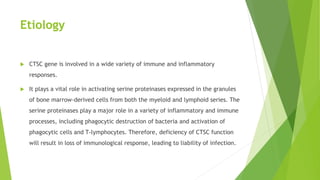Papillon-Lèfevre Syndrome (PLS) is a rare genetic disorder that causes severe gum disease and early loss of both baby and adult teeth. It is caused by mutations in the CTSC gene which encodes an enzyme important for immune function. Patients with PLS experience rapid gum inflammation and bone loss around teeth from a young age, resulting in pain, infection, and premature tooth loss. Skin lesions also develop on the hands and feet. Treatment focuses on antibiotics, oral hygiene, gum treatment, and early tooth extraction to prevent further infection and bone loss, with the goal of restoring chewing function through prosthetics or implants.





























